Yesterday we recapped the moves at the top of the table, today it's time for everybody else. AC Milan AC Milan’s transfer campaign was one of the most interesting, but at the same time, the team remains one of the most undecipherable early in the season. The triumvirate in charge of the transfer market formed by Zvonimir Boban, Paolo Maldini, and Frederic Massara has, first of all, succeeded in reducing the cost of the roster by about 18.5 million after the exclusion from the European cups for failure to maintain the parameters of the FFP, despite spending €109 million in newcomers. This is thanks to the sales (the most important was that of Patrick Cutrone to Wolverhampton for €18+2 million) and the release of free agents such as Abate, Montolivo, Zapata, and Strinic. As for their buys. They purchased Theo Hernandez from Real Madrid, who was on loan last year to Real Sociedad, for 20 million. A leftback was not objectively a priority of the club, at the time of purchase already had three on their roster, but Hernandez is only 21 years old and along with his brother (bought by Bayern Munich from Atlético for 80 million) is considered one of the most promising defenders of his generation. 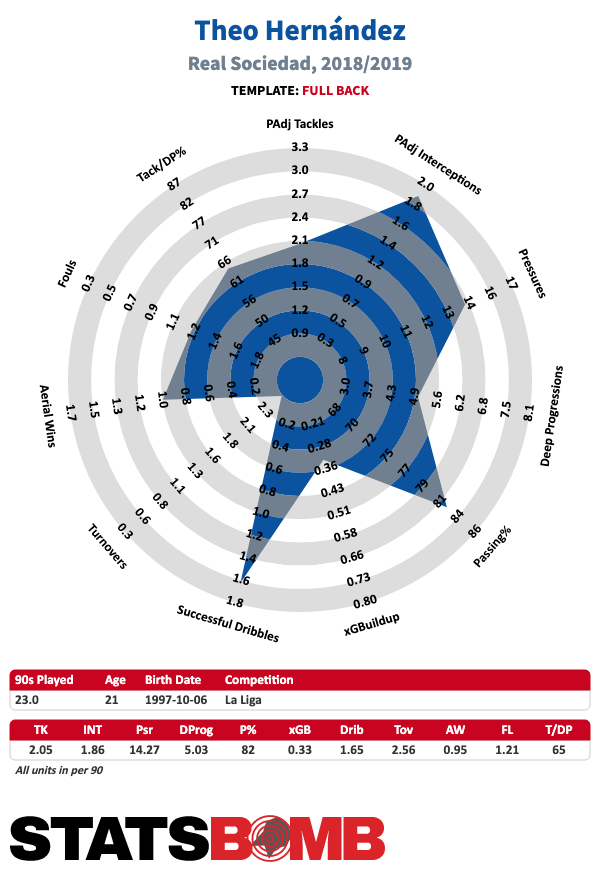 They also bought Leo Duarte, a pacey center back, good in aerial duels who will complete the pool of defenders, offering an alternative behind Alessio Romagnoli and Musacchio. Ismael Bennacer was one of the most exciting midfielders to watch in the latest edition of Serie A and Milan got him from Empoli for 16 million. The Algerian has already become the starting holding midfielder of the new coach Marco Giampaolo and will be a key piece of next season (I already wrote a profile of him here). Paying 8 million, the Rossoneri have also snatched Rade Krunic from relegated, a well-suited role-player who had perhaps his best season playing alongside Bennacer and who has already been coached by Giampaolo. The largest investments were made in the attack. The 20-year-old Portuguese striker Rafael Leao arrived from Lille as soon as Cutrone's farewell faded out. Strong and with really good technique, he can be deployed in multiple roles of the attack.
They also bought Leo Duarte, a pacey center back, good in aerial duels who will complete the pool of defenders, offering an alternative behind Alessio Romagnoli and Musacchio. Ismael Bennacer was one of the most exciting midfielders to watch in the latest edition of Serie A and Milan got him from Empoli for 16 million. The Algerian has already become the starting holding midfielder of the new coach Marco Giampaolo and will be a key piece of next season (I already wrote a profile of him here). Paying 8 million, the Rossoneri have also snatched Rade Krunic from relegated, a well-suited role-player who had perhaps his best season playing alongside Bennacer and who has already been coached by Giampaolo. The largest investments were made in the attack. The 20-year-old Portuguese striker Rafael Leao arrived from Lille as soon as Cutrone's farewell faded out. Strong and with really good technique, he can be deployed in multiple roles of the attack. 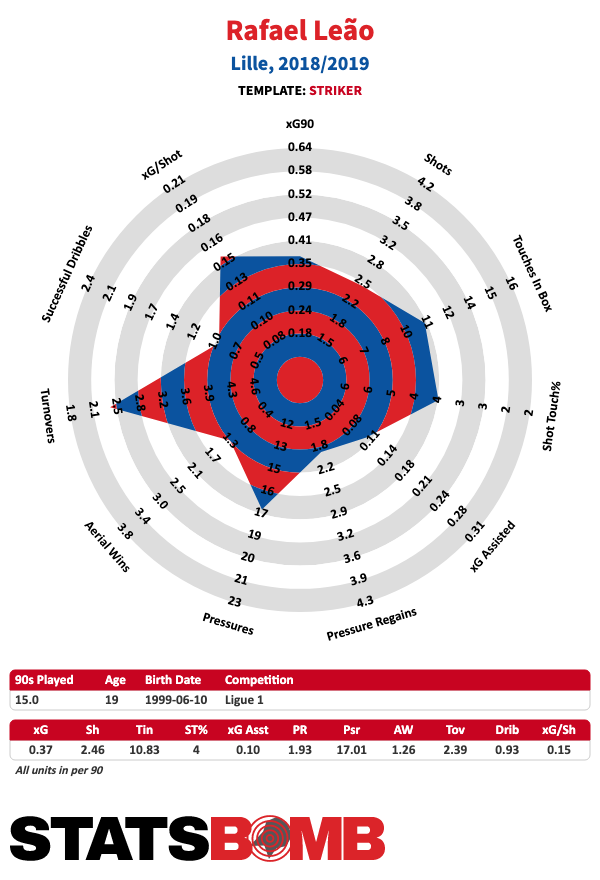 Last season Leao played mostly as a central striker, with an impressive contribution of 0.60 non-penalty goals and 0.20 assist per 90. Other than centrally, he was also employed on the left side, where he used his speed to attack the inside of the pitch. The young Portuguese prospect generated 0.37 xG and 0.10 xG assisted per 90, values that are exactly half of his effective production, but that is still really valuable for a player born in 1999. With Giampaolo ready to switch from the 4-3-1-2 to the 4-3-3 it will be interesting to see where Leao will be deployed, because he could be Krzysztof Piątek’s partner in a two-man attack, or act as the central striker or the left inside forward in a 4-3-3. We could make similar questions about Ante Rebić, who Milan got on a 2-year loan with option to buy from Eintracht Frankfurt, with André Silva going to the Bundesliga on loan. At Eintracht, Rebić played in a hybrid role between second striker and left winger and Giampaolo could field him on the left in a 4-3-3 or in a more central position in a 4-2-3-1.
Last season Leao played mostly as a central striker, with an impressive contribution of 0.60 non-penalty goals and 0.20 assist per 90. Other than centrally, he was also employed on the left side, where he used his speed to attack the inside of the pitch. The young Portuguese prospect generated 0.37 xG and 0.10 xG assisted per 90, values that are exactly half of his effective production, but that is still really valuable for a player born in 1999. With Giampaolo ready to switch from the 4-3-1-2 to the 4-3-3 it will be interesting to see where Leao will be deployed, because he could be Krzysztof Piątek’s partner in a two-man attack, or act as the central striker or the left inside forward in a 4-3-3. We could make similar questions about Ante Rebić, who Milan got on a 2-year loan with option to buy from Eintracht Frankfurt, with André Silva going to the Bundesliga on loan. At Eintracht, Rebić played in a hybrid role between second striker and left winger and Giampaolo could field him on the left in a 4-3-3 or in a more central position in a 4-2-3-1. 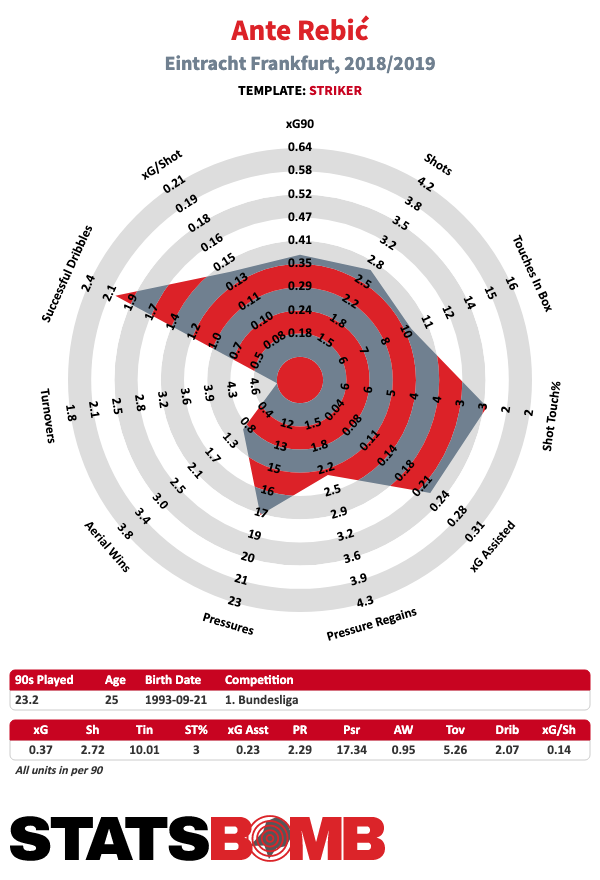 Rebić is a good dribbler, capable of contributing goals, with 17 goals in his 78 Bundesliga matches. Last season he completed just 59% of his passes, with 0.23 assisted xG per 90. No other player in the top-5 European League had such a high value in xG assisted with a lower passing percentage. As you may have guessed, there are still a lot of ifs and hows about Milan starting eleven, especially in attack, and we are all curious to see how Giampaolo will employ the newcomers. AS Roma This is Roma's first season in the 21st century without Francesco Totti or Daniele De Rossi. In addition to the end of an era, the Giallorossi have a new coach, Paulo Fonseca, and have added to the roster a whopping ten new purchases. The summer saw yet another revolution promoted by the American ownership, which chose a coach with modern principles of play but who had never trained in a top European championship. After five seasons in the Italian capital, Kostas Manolas was sold to Napoli, in exchange for Amadou Diawara (who has always profiled as a very good defensive midfielder, despite somewhat limited playing time at Napoli) and money. Three central defenders came to replace the Greek: Gianluca Mancini from Atalanta (for €23 million), Mert Cetin from Gençlerbirligi (for €3 million) and Chris Smalling from Man United, on loan for €3 million (wait a second...Smalling? Yes Smalling). Mancini is the most interesting of the three. At 23 he is still a bit raw, but he is one of the most promising young defenders in Italy. Mancini has been a bit of a late-bloomer, but he is strong, good at marking and also relatively agile considering his build. Yet, Compared to Atalanta, where he shone in Gasperini's defence, based on man marking and anticipation, he will have to adapt to a completely new system in which the defense works together and follows the rules of zonal marking. As a bonus, he's a threat on set pieces so much so that last season he managed to score five goals.
Rebić is a good dribbler, capable of contributing goals, with 17 goals in his 78 Bundesliga matches. Last season he completed just 59% of his passes, with 0.23 assisted xG per 90. No other player in the top-5 European League had such a high value in xG assisted with a lower passing percentage. As you may have guessed, there are still a lot of ifs and hows about Milan starting eleven, especially in attack, and we are all curious to see how Giampaolo will employ the newcomers. AS Roma This is Roma's first season in the 21st century without Francesco Totti or Daniele De Rossi. In addition to the end of an era, the Giallorossi have a new coach, Paulo Fonseca, and have added to the roster a whopping ten new purchases. The summer saw yet another revolution promoted by the American ownership, which chose a coach with modern principles of play but who had never trained in a top European championship. After five seasons in the Italian capital, Kostas Manolas was sold to Napoli, in exchange for Amadou Diawara (who has always profiled as a very good defensive midfielder, despite somewhat limited playing time at Napoli) and money. Three central defenders came to replace the Greek: Gianluca Mancini from Atalanta (for €23 million), Mert Cetin from Gençlerbirligi (for €3 million) and Chris Smalling from Man United, on loan for €3 million (wait a second...Smalling? Yes Smalling). Mancini is the most interesting of the three. At 23 he is still a bit raw, but he is one of the most promising young defenders in Italy. Mancini has been a bit of a late-bloomer, but he is strong, good at marking and also relatively agile considering his build. Yet, Compared to Atalanta, where he shone in Gasperini's defence, based on man marking and anticipation, he will have to adapt to a completely new system in which the defense works together and follows the rules of zonal marking. As a bonus, he's a threat on set pieces so much so that last season he managed to score five goals. 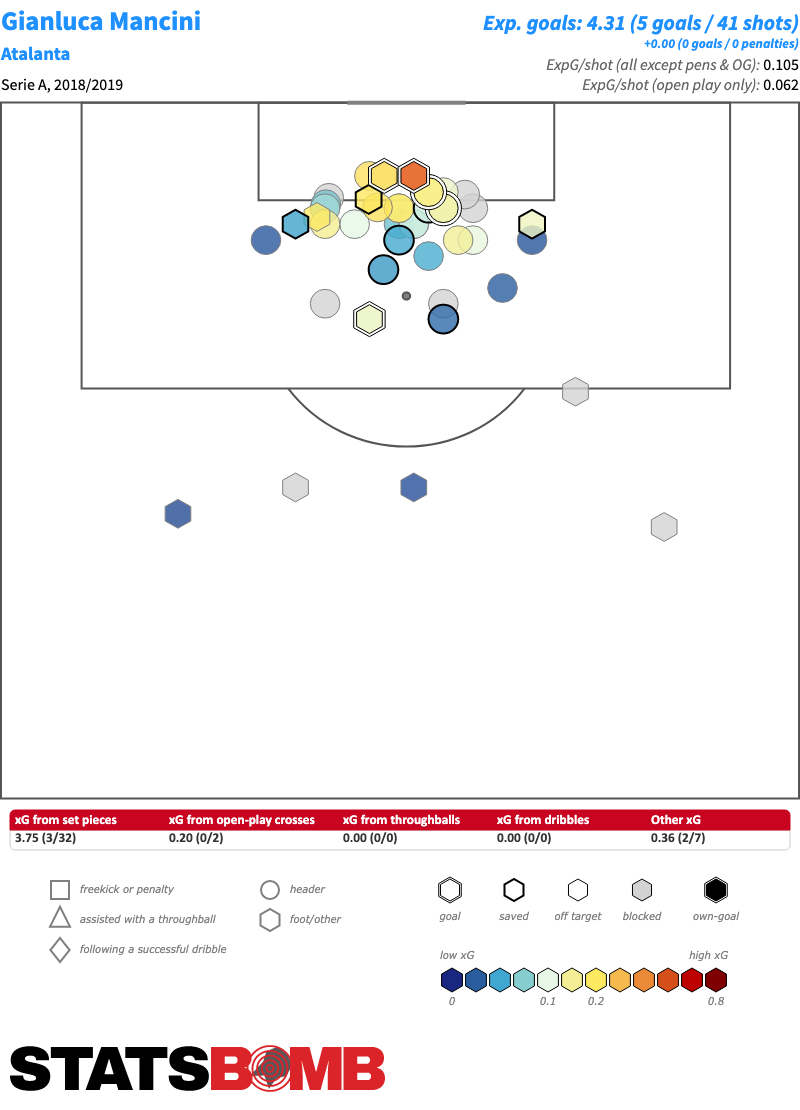 After Robin Olsen's flop last season, Roma also needed a goalkeeper: they chose Betis' Pau Lopez a sweeper-keeper strong with the ball at his feet, as requested by Fonseca. They paid €23 million plus €7 million in potential bonuses. While his ability to come off his line might be impressive, his shot stopping last season was not. He was below average (3% worse than what an average keeper would be expected to save) and that should worrying, considering that it was worse than Olsen’s -1% .
After Robin Olsen's flop last season, Roma also needed a goalkeeper: they chose Betis' Pau Lopez a sweeper-keeper strong with the ball at his feet, as requested by Fonseca. They paid €23 million plus €7 million in potential bonuses. While his ability to come off his line might be impressive, his shot stopping last season was not. He was below average (3% worse than what an average keeper would be expected to save) and that should worrying, considering that it was worse than Olsen’s -1% . 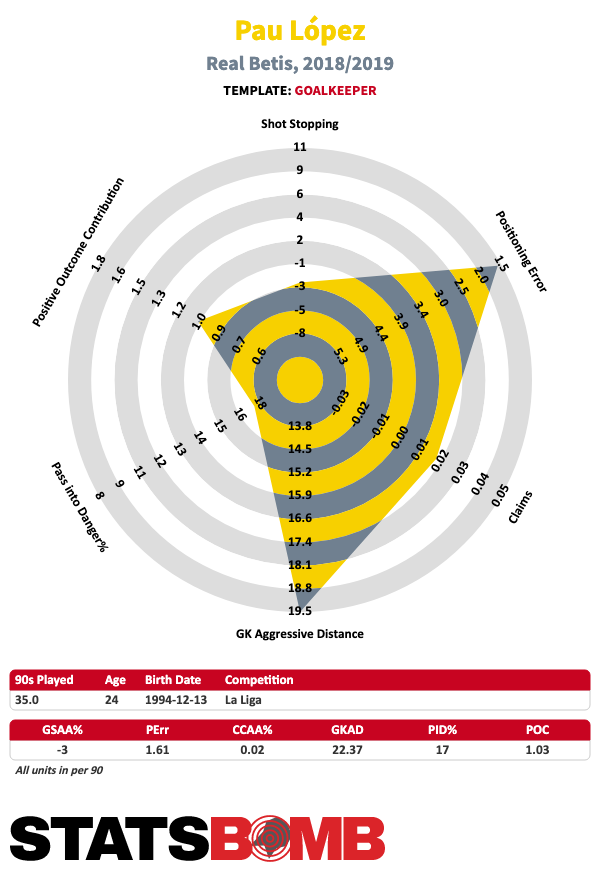 Leonardo Spinazzola, who was basically traded from Juventus for Luca Pellegrini, will provide an alternative to Aleksandar Kolarov at leftback. The midfield was reinforced numerically with Jordan Veretout, a complete midfielder who was appreciated in Florence for his tactical intelligence, rather than for stand-out metrics. Henrikh Mkhitaryan (€3 million loan) and Nikola Kalinic (€2 million loan plus option to buy) were the purchases of the last few hours of the transfer campaign. Two players looking for a new start in Rome who will have to prove they can still be decisive at the highest level. The Armenian even revealed that he fell out of love with football during his spell in the Premier League. He'll have to put his bad time behind him and put his creativity at the service of the team, considering that the injuries of Diego Perotti and Cengiz Under will probably require him to start this weekend already.
Leonardo Spinazzola, who was basically traded from Juventus for Luca Pellegrini, will provide an alternative to Aleksandar Kolarov at leftback. The midfield was reinforced numerically with Jordan Veretout, a complete midfielder who was appreciated in Florence for his tactical intelligence, rather than for stand-out metrics. Henrikh Mkhitaryan (€3 million loan) and Nikola Kalinic (€2 million loan plus option to buy) were the purchases of the last few hours of the transfer campaign. Two players looking for a new start in Rome who will have to prove they can still be decisive at the highest level. The Armenian even revealed that he fell out of love with football during his spell in the Premier League. He'll have to put his bad time behind him and put his creativity at the service of the team, considering that the injuries of Diego Perotti and Cengiz Under will probably require him to start this weekend already. 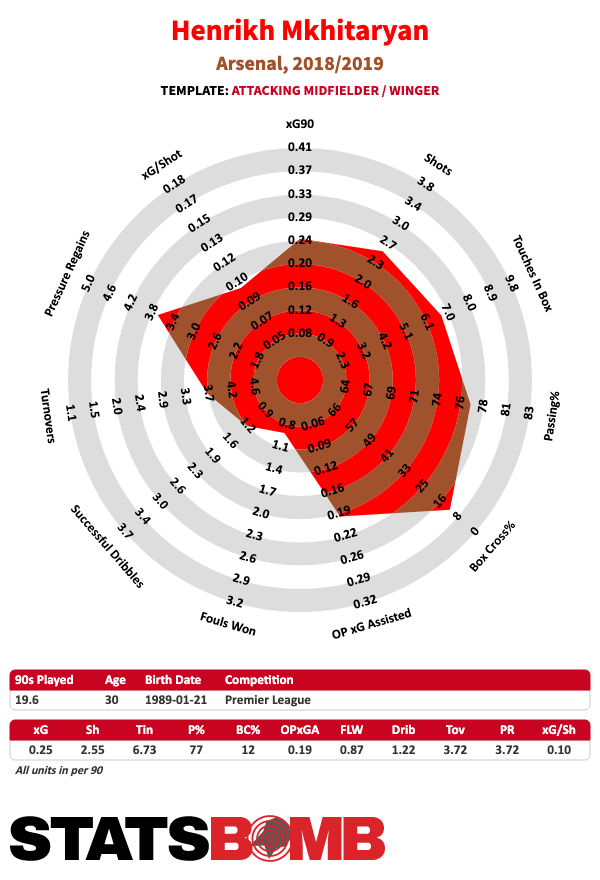 Overall Roma don't seem to have improved since last season and, after yet another cycle of novelty, it might not be a surprise to find the team out of the top-4 again. Who else? There are still some signings that surely deserve a mention. Bologna splashed over €68 million on the transfer market and became football hipsters’ new favorite team with signing such as Japanese rightback and center back Takehiro Tomiyasu, who ,playing on the right flank, immediately become their most influent player in build-up play. They also added two holding midfielders: old fox Gary Medel and 21-year-old Nicolas Dominguez, considered one of the most promising Argentinean midfielders. Another interesting singing is Andreas Skov Olsen, a winger that scored like crazy in Denmark and he still just 19 years old. Brescia brought in Finnish goalkeeper Jesse Joronen from Copenaghen but above all they signed free agent Mario Balotelli to foster their hopes to stay in the Serie A, while the other two newly promoted sides Lecce and Hellas Verona signed respectively Khouma Babacar and Mariusz Stępiński. To celebrate the club's centenary, Cagliari’s president Tommaso Giulini didn't mind spending and put together a midfield with Radja Nainggolan on loan from Inter, Marko Rog (€15 million from Napoli) and Naithan Nandez (18 million from Boca). Fiorentina snatched midfielder Eirk Pulgar from Bologna and bought Kevin-Prince Boateng and fullback Pol Lirola from Sassuolo. Finally, they convinced Franck Ribéry to play in Italy for 2 years for a total salary of 8 million and got Brazilian striker Pedro for 15 million. If President Preziosi revolutionized Genoa, with ex Ajax’s skipper Lasse Schone as the main purchase, Lazio has remained more or less the same except for the acquisitions of Slovakian center back Denis Vavro and wingback Manuel Lazzari. Sampdoria’s transfer campaign was negatively affected by the negotiations for the sale of the club with defender Jeison Murillo being their most important investment, Sassuolo was one of the most active teams, especially on the last few days. They got 3 new center backs (including Napoli’s Vlad Chiriches), changed two out of three of their midfielders with the acquisition of Pedro Obiang and the loan of Hamed Traorè from Juventus and added two more strikers in Francesco Caputo (16 goals with Empoli last season) and Grégoire Defrel (who scored 12 times with Sampdoria in 18/19). Spal restyled their wings, with the signings of Marco D’Alessandro and Federico Di Francesco who can also play upfront. Exactly like Simone Verdi can, a player that Torino chased throughout the campaign and who finally signed on the very last day. Udinese was quite shy on the market but they managed to keep Rodrigo De Paul: they got Palermo’s free agents Mato Jajalo and Ilija Nestorovski (11 goals in 2016/17, his only Serie A season) and signed Brazilian centerback Rodrigo Becao, that already got them 3 points scoring the lone goal in Udinese – Milan.
Overall Roma don't seem to have improved since last season and, after yet another cycle of novelty, it might not be a surprise to find the team out of the top-4 again. Who else? There are still some signings that surely deserve a mention. Bologna splashed over €68 million on the transfer market and became football hipsters’ new favorite team with signing such as Japanese rightback and center back Takehiro Tomiyasu, who ,playing on the right flank, immediately become their most influent player in build-up play. They also added two holding midfielders: old fox Gary Medel and 21-year-old Nicolas Dominguez, considered one of the most promising Argentinean midfielders. Another interesting singing is Andreas Skov Olsen, a winger that scored like crazy in Denmark and he still just 19 years old. Brescia brought in Finnish goalkeeper Jesse Joronen from Copenaghen but above all they signed free agent Mario Balotelli to foster their hopes to stay in the Serie A, while the other two newly promoted sides Lecce and Hellas Verona signed respectively Khouma Babacar and Mariusz Stępiński. To celebrate the club's centenary, Cagliari’s president Tommaso Giulini didn't mind spending and put together a midfield with Radja Nainggolan on loan from Inter, Marko Rog (€15 million from Napoli) and Naithan Nandez (18 million from Boca). Fiorentina snatched midfielder Eirk Pulgar from Bologna and bought Kevin-Prince Boateng and fullback Pol Lirola from Sassuolo. Finally, they convinced Franck Ribéry to play in Italy for 2 years for a total salary of 8 million and got Brazilian striker Pedro for 15 million. If President Preziosi revolutionized Genoa, with ex Ajax’s skipper Lasse Schone as the main purchase, Lazio has remained more or less the same except for the acquisitions of Slovakian center back Denis Vavro and wingback Manuel Lazzari. Sampdoria’s transfer campaign was negatively affected by the negotiations for the sale of the club with defender Jeison Murillo being their most important investment, Sassuolo was one of the most active teams, especially on the last few days. They got 3 new center backs (including Napoli’s Vlad Chiriches), changed two out of three of their midfielders with the acquisition of Pedro Obiang and the loan of Hamed Traorè from Juventus and added two more strikers in Francesco Caputo (16 goals with Empoli last season) and Grégoire Defrel (who scored 12 times with Sampdoria in 18/19). Spal restyled their wings, with the signings of Marco D’Alessandro and Federico Di Francesco who can also play upfront. Exactly like Simone Verdi can, a player that Torino chased throughout the campaign and who finally signed on the very last day. Udinese was quite shy on the market but they managed to keep Rodrigo De Paul: they got Palermo’s free agents Mato Jajalo and Ilija Nestorovski (11 goals in 2016/17, his only Serie A season) and signed Brazilian centerback Rodrigo Becao, that already got them 3 points scoring the lone goal in Udinese – Milan.
2019
Serie A summer transfer roundup, part two
By admin
|
September 13, 2019